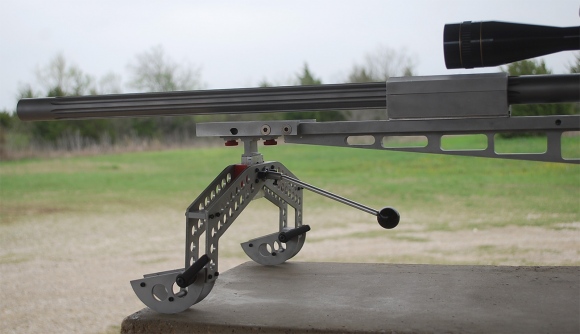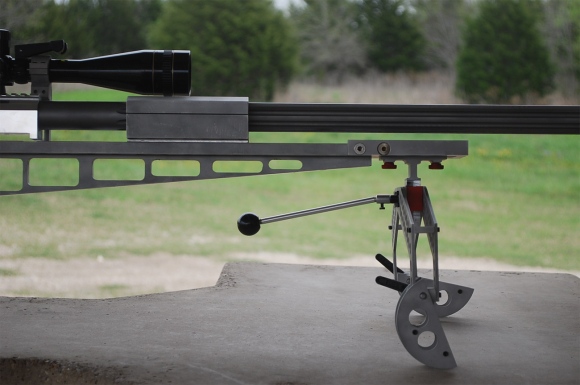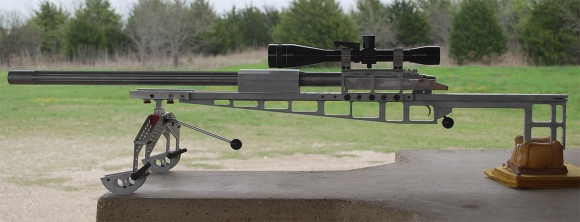“Texas T” — Radical, All-Metal F-TR Rifle from Richard King
Report by Richard King (King’s Armory, Texas; ‘Kings X’ on our Forum)
With all the talk from Vince Bottomley in the April issue of Target Shooter about aluminum stocks, I thought you might like to see my latest project. This is my personal gun, built the way I wanted it. I know it’s radical and some may not care for it. But it works.
This is pretty much an all-aluminum rifle. The action is a Kelbly F-Class with a Shilen stainless steel competition trigger. The scope is a 1″-tube Leupold 36X with a Tucker Conversion set in Jewell spherical bearing rings. The .223 barrel is Pac-Nor 3-groove, 1:6.5″-twist mounted in a “V”-type barrel block. The bipod has vertical adjustment only via a dovetail slide activated by a stick handle. It works like a joy-stick, but for vertical only. I adjust for windage by moving the rear sandbag.
The 30″ barrel is 1.250″ in diameter. With the barrel block forward, the vibrations should be at a low frequency. Instead of one long rod whipping, I now have two short rods (barrel haves) being dampened. This is my fourth barrel block gun. They work, but so does a good pillar-bedded action. I just do stuff a little different.
The vertical “keel” down the bottom of the stock stops the “spring” of a flat-bar stock. There is little, if any, noticeable flex before or during recoil. The long length of the stock, the fat barrel, and the forward-mounted barrel block work together to keep the gun from rising off the ground. BUT, remember this is a .223 Rem rifle. A .308 Win version might act very differently. I may try a .308-barreled action soon, just to see what happens. But I will stick with the .223 Rem as my choice for match shooting.
 The offset scope idea came from a benchrest “rail” gun. In truth, the whole concept came from a rail gun — just adapted to being shot off a bipod. Sure it isn’t directly over the bore. It is about 1.5″ over to the left. So if you want the scope to be zeroed on the center of the target, you have to adjust for the offset. At 100 yards that is 1.5 MOA. But at 300 it is only 0.5 MOA, at 600 only a ¼-MOA, and at 1000 about 1 click on my scope.
The offset scope idea came from a benchrest “rail” gun. In truth, the whole concept came from a rail gun — just adapted to being shot off a bipod. Sure it isn’t directly over the bore. It is about 1.5″ over to the left. So if you want the scope to be zeroed on the center of the target, you have to adjust for the offset. At 100 yards that is 1.5 MOA. But at 300 it is only 0.5 MOA, at 600 only a ¼-MOA, and at 1000 about 1 click on my scope.
What the offset DOES do for me is eliminate any cheek pressure. My cheek never touches the stock. Since this is only a .223 Rem, I don’t put and shoulder pressure behind it. And I don’t have a pistol grip to hang on to, but I do put my thumb behind the trigger guard and “pinch” the two-ounce trigger.
The offset scope placement could interfere with loading a dual-port action from the left. That’s not a problem for me as I set my spotting scope up on the left side very close to the rifle. I have plenty of time to reload from the right side while the target is in the pits being scored.
Again — this is my rifle. It is designed for my style of shooting. It is not meant to be a universal “fit all” for the general public. However, I will say the design is adaptable. I can easily convert the system to run in F-Open Class. I would drop a big-bore barreled action into the “V” block, slide on a heavier pre-zeroed scope and rings, add plates on the sides up front to bring the width to 3”, and maybe a recoil pad. It might be interesting to offset the wings up from to counter torque of the big bullets. But I would also have to offset the rear bag rider to get the gun to recoil straight back.
How the Gun Performs
I have had “T” to the range only twice for load development. It groups like my present barrel-blocked 223 F-TR gun. But it’s much easier to shoot and it only moves about 3/4” — straight back. I tried to build am omni-directional joy-stick bipod but I could not get all the side-to-side wiggle out of it. So I have set it up so it only moves up and down (horizontal movement is locked-out). As it works now, the joystick on the bipod lets me set elevation on the target quickly (with up/down adjustment). Then, to adjust for windage, I slide my rear bag side-to-side as needed. Once set, I just tickle the trigger and smile.
Gun Handling — Shoot It Like a Bench-Gun
I basically shoot the gun with no cheek or body contact. I don’t grip it, other than maybe a pinch on the trigger guard. The scope was offset to the left to help the shooter move off the gun and avoid the possibility of head/cheek contact with the stock.Listen to Richard King Explain How He Shoots his ‘Texas-T’ Rifle: [haiku url=”http://accurateshooter.net/Video/RichKingTalks.mp3″ Title=”Richard King Talks”]
CLICK PHOTOS to See Big Size
Similar Posts:
- Richard King’s Radical .223 Rem F-Class Rig
- Tooley's Radical New Offset Stock
- Danny Biggs’ Height-Adjusting F-Class Bipod
- Tooley Offset Stock Fights Torque on Large-Caliber Rifles
- The Evolution of the Modern F-TR Rifle
Tags: .223 Rem, .308 Win, Aluminum stock, Bipod, F-Class, F-TR, F/TR, Gunsmithing, Joystick, Offset Stock, Richard King, Texas























This is the kind of innovative thinking we need and why overly restrictive rules will not help advance F-Class. Maybe Richard’s approach will work and maybe it won’t. Regardless, it shows he’s thinking and not just following the herd. Nice work, Richard.
I like the truss rib down the bottom of the stock. In testing with F-O aluminum stocks we did the heavier the recoil the poorer the performance with the design we used. The rib may just be the saving grace.
Looks like an old McMillian stock used in bechrest a long long long time ago. There was one that popped up on e-bay a few months back, I tried to buy it at scrap rate, and the stock brought about 80 bucks, it was for a flat bottom action like a Panda, or a sleeved Remington. I would say the stock is either an Old McMillian that they added the front rest on, or they copied a McMillian to the t. There is a nice picture of one in Glen Newicks book. It must have not worked well, as you don’t see the design used anymore.
Excluding weight, is there any reason why no one uses any more than one mounting system?: ie
2 barrel blocks
1 longer barrel block
or even pillar bed action AND barrel block
each of these would increase the dampening provided wouldnt they? and wurely the mounting blocks could be skeletonised some also to shave weight. (drill/mill holes in the vertical plane?)
to my (very) basic knowledge these would all lessen the barrel whip/flex – a test gun with a straight barrel could simply have extra mounting wholes drill in the stock to enable moving the block forward backward or modifying block length.
if anyone in aus would build one similar to above (with grip and butt pad though) id love to try it.
Richard – awesome work! I agree – the barrel-block system is the way forward where we have a sufficient weight allowance – i.e. F Class.
I’m using the Trueflite barrel-block stock for my next F Open build.
Your bi-pod looks worthy of an article in itself.
I didn’t think free recoil was allowed in F class? Is it?
Thanks Steve.
Jim – the rib was put there to stiffen the stock. It works.
Pat – I think the BR stock was made by CSC. McMillan has always been fiberglass. Yes I did follow (steal) some of the design from that stock but added the barrel block. This is like a BR rail gun without the bottom guide plate and a butt section added.
Gabe – I missed that rule. I will look it up. It will be hard to tell that I am not holding the gun.
How does it shoot? Also, I believe that if you tie a barreled action down in two places, as it heats up, and the barrel lengthens, stress with be created that will degrade accuracy. You can have it touch, and allow it to slide, but IMO if it is clamped or bolted in two places (the action and barrel for instance) the results will not be as good as if it is only restrained in one place (action or block).
Boyd – I agree with just one barrel block. I see that Speedy is having good luck with a split block that lookings like a scope base with rings on either end.
The scope on this gun is an old scope that is new to me. It has tracking problems so I do not really trust it.
Tried some new powder and that isn’t working out. Back to Reloader 15 now so am starting load development over. Right now the 80.5 Berger are runing in the mid 4s at 2940 fps and the 90 Berger in the mid 3s at 2795 fps. I am getting 4 in a hole and a flyer(the flyer is included in group size).
I looked it up.
http://compete.nra.org/documents/pdf/compete/RuleBooks/HPR/hpr-book.pdf
3.4 (a) (3)
Gabe:
Please recheck that link/citation – “3.4 Reduced Capacity Magazine”, just the one paragraph.
I guess I forgot to add you have to go to the “F-Class” section first and then to 3.4 (a) (3)
So it should be:
Section 22
3.4 (a) (3)
Appreciate this thread is now somewhat old, but was this allowed under US F-TR rules? The “from the shoulder” words make me wonder…
I have a similar concept (very different manufacture, but similar underlying concept mixing up a few ideas from this and from the Jennings stock) which I’m making up. Over here we shoot under UK/ICFRA rules which don’t have the shoot from the shoulder wording, but I wonder whether the US rules will prevent me from shooting it in the US, when I come over…
TIA,
Andrew